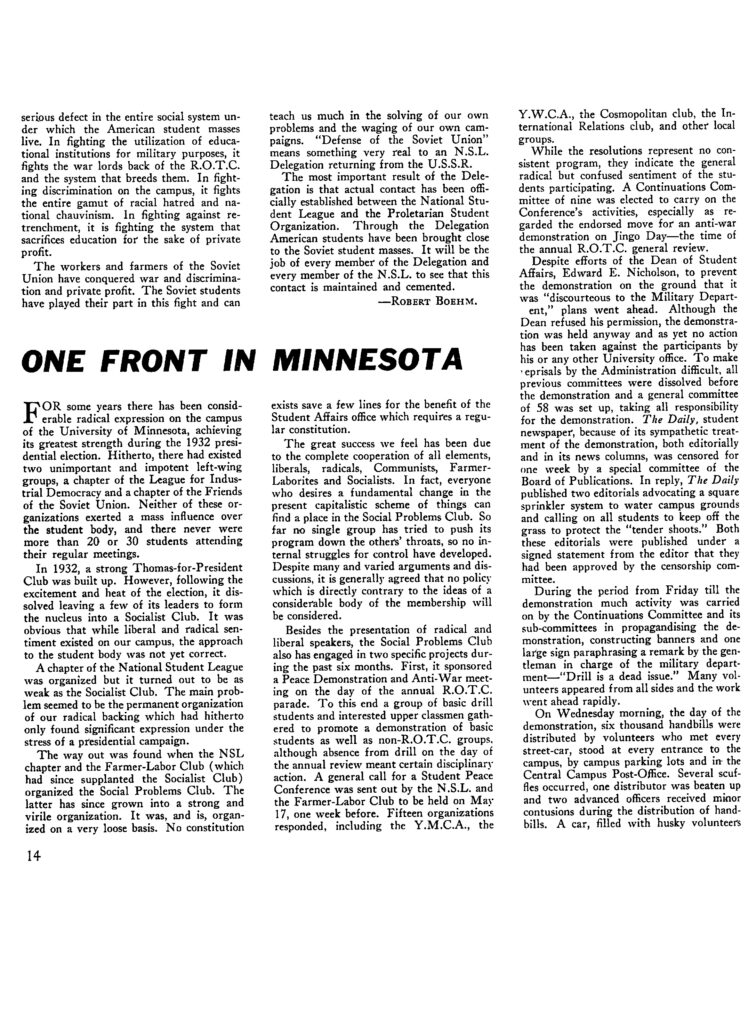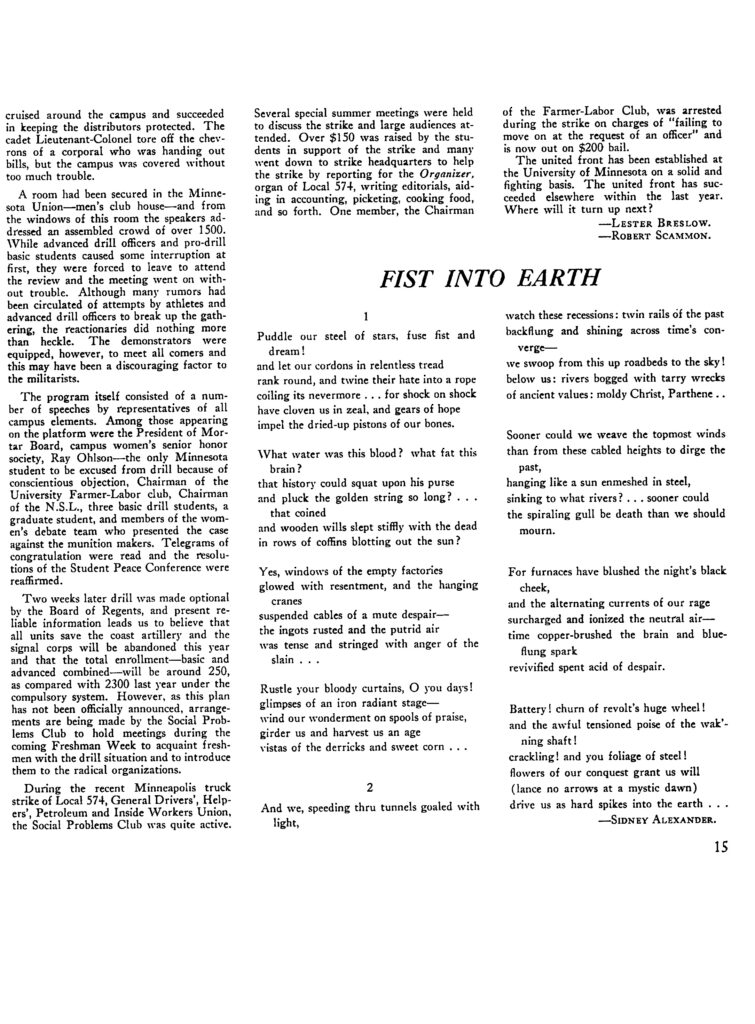The Student Review was a publication of the National Student League, one of the first organizations of the student movement in the 1930s. Founded in 1931 in New York City with students from private and public universities and colleges. It worked on a variety of issues that included defending the rights of students against university censorship, supporting coal miners striking in Harlan County Kentucky in 1932, and anti-war peace activism in the period. The NSL grew quickly into a national movement. They organized the first successful nation-wide campus anti-war strikes in 1934 and 1935. The National Strike Against War drew over 100,000 people each year. They joined with the Student League for Industrial Democracy to create the American Student Union in 1935, which had an active chapter at the University of Minnesota.
Breslow and Scammon’s brief article offers a remarkable view on student activist at the University of Minnesota in 1934. It describes several examples of antiwar activism, which include the well documented demonstration against the ROTC, and describes in detail the speeches and participants who spoke from a window in the Minnesota Union. It also describes a Student Peace Conference the previous week, and participation in the Truckers’ strike the following month.
Their article emphasizes the importance of creating alliances across groups that ranged from the YMCA and YWCA, to the Farmer-Labor Party, to Socialists, Communists, liberals and progressives. They explained the importance of building a movement from shared ideas, rather than a single ideology, and referred to themselves as “One Front .”
This article is a repudiation of Edward Nicholson and Ray P. Chase’s contention that left-wing students were all communists, or that Lester Breslow was a communist. Rather, it reveals their approach to political activism that valued compromise to create a pluralist left-wing movement. They were critical of capitalism, and no outside organization controlled their “one front.”This view was also expressed By Eric Sevareid in his memoir Not So Wild A Dream and Rosalind Matusow Belmont’s in her oral history with the Minnesota Historical Society, both of which are cited throughout the website.
The Student Review was a publication of the National Student League, one of the first organizations of the student movement in the 1930s. Founded in 1931 in New York City with students from private and public universities and colleges. It worked on a variety of issues that included defending the rights of students against university censorship, supporting coal miners striking in Harlan County Kentucky in 1932, and anti-war peace activism in the period. The NSL grew quickly into a national movement. They organized the first successful nation-wide campus anti-war strikes in 1934 and 1935. The National Strike Against War drew over 100,000 people each year. They joined with the Student League for Industrial Democracy to create the American Student Union in 1935, which had an active chapter at the University of Minnesota.
Breslow and Scammon’s brief article offers a remarkable view on student activist at the University of Minnesota in 1934. It describes several examples of antiwar activism, which include the well documented demonstration against the ROTC, and describes in detail the speeches and participants who spoke from a window in the Minnesota Union. It also describes a Student Peace Conference the previous week, and participation in the Truckers’ strike the following month.
Their article emphasizes the importance of creating alliances across groups that ranged from the YMCA and YWCA, to the Farmer-Labor Party, to Socialists, Communists, liberals and progressives. They explained the importance of building a movement from shared ideas, rather than a single ideology, and referred to themselves as “One Front .”
This article is a repudiation of Edward Nicholson and Ray P. Chase’s contention that left-wing students were all communists, or that Lester Breslow was a communist. Rather, it reveals their approach to political activism that valued compromise to create a pluralist left-wing movement. They were critical of capitalism, and no outside organization controlled their “one front.”This view was also expressed By Eric Sevareid in his memoir Not So Wild A Dream and Rosalind Matusow Belmont’s in her oral history with the Minnesota Historical Society, both of which are cited throughout the website.
If you have information about the University of Minnesota in the 1930s that you would like to add, or reflections on other campus struggles, please contact us at prell001@umn.edu
Copyright 2017. All rights reserved.
Individual documents remain the property of their repositories — consult with those institutions about access and reuse.

